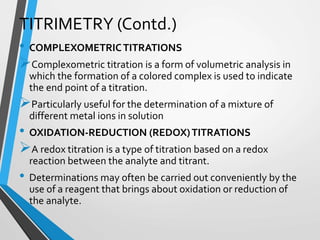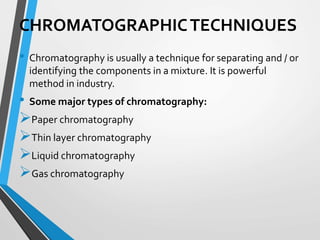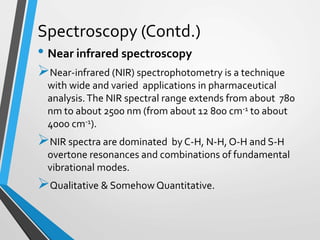The document discusses various analytical techniques used in pharmaceutical analysis to identify and quantify chemical substances. It describes techniques including gravimetric analysis, titrimetry, polarimetry, refractometry, chromatography, spectroscopy, electrochemistry, kinetics methods, and hyphenated techniques. Specifically, it provides details on the principles and applications of techniques like titration, high performance liquid chromatography, UV-visible spectroscopy, infrared spectroscopy, mass spectroscopy, and hyphenated methods like LC-MS and GC-MS.

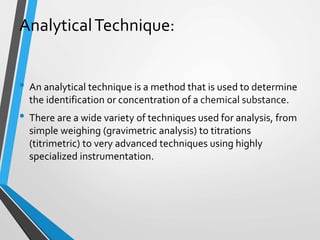
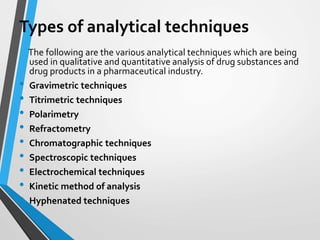

![TITRIMETRY
•TITRATION
Measurement of the volume of a unknown solution (the analyte) with a known
concentration of a reagent(the titrant).
• DIRECTTITRATIONS
Direct titration is the treatment of a soluble substance, contained in solution
in a suitable vessel (the titrate), with an appropriate standardized solution (the
titrant), the endpoint being determined instrumentally or visually with the aid
of a suitable indicator.
The titrant is added from a suitable burette and is so chosen, with respect to
its strength (normality), that the volume added is between 30% and 100% of
the rated capacity of the burette. [NOTE—Where less than 10 mL of titrant is
required, a suitable microburet is to be used.]The endpoint is approached
directly but cautiously, and finally the titrant is added dropwise from the buret
in order that the final drop added will not overrun the endpoint.The quantity
of the substance being titrated may be calculated from the volume and the
normality or molarity factor of the titrant and the equivalence factor for the
substance given in the individual monograph.](https://image.slidesharecdn.com/analyticaltechniquesinpharmaceutical-181230073615/85/Analytical-techniques-in-pharmaceutical-5-320.jpg)

